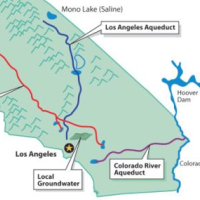L.A.’s Mono Lake Water Running Out Just Ahead of Ecosystem Crisis

In April, after the Sierra Nevada snowpack that feeds Mono Lake east of Yosemite National Park failed to materialize, some environmentalists hailed the devastating fallout from the drought as the lake’s savior.
A 1994 state agreement, reached after years of litigation, compelled the Los Angeles Department of Water and Power (LADWP) to cut its diversion of the shallow, briny lake by 70% if the surface elevation got below 6,380 feet. It fell a foot short. Two more feet and L.A. loses all its Mono Lake water.
The 1-million-year-old lake, which once covered a vast expanse, still has a very productive ecosystem based. At the base of the food chain is a high population of single-celled planktonic algae. Brine shrimp feed on the algae and, while they aren’t human food, they provide a nesting habitat for 2 million migratory birds, including 35 species of shorebirds. Minerals that have dissolved in the water make it far too salty for fish to survive.
Despite the respite from L.A.’s rapacious thirst, it’s hard to imagine much of a future for Mono Lake in the Age of Drought. It has been the subject of lengthy litigation over its decline, beginning with a Public Trust lawsuit in 1979, and is about to reach a new marker of devastation.
The Los Angeles Times sketched out the very sketchy-looking future of California’s second-largest gull colony. Coyotes are poised to cross an emerging land bridge to Negit Island and other islets, where eggs and chicks are fair game. They are known to swim 200 yards for gull eggs. The land bridge was exposed in the 1970s and the 1990s and it wasn’t pretty.
“I'll be terrified if the lake level drops another few feet,” Kristie Nelson, a biologist doing research on the gulls, told the Times.
Mono Lake, like Owens Dry Lake, has a long history of feeding the Los Angeles Aqueduct to its detriment. The prehistoric sea had already shrunk considerably by 1941 when L.A. began to divert 30,000 acre-feet of water a year, but the remaining Mono Lake had a surface elevation of 6,417 feet.
It has declined 38 feet and is 13 feet below the minimum acceptable level of lake management. The historic low is 6,372 feet in 1982.
As is the case across the state, “There's no contingency plan on the shelf for record drought,” Geoffrey McQuilkin, executive director of the Mono Lake Committee, told the Times. He reckons the legal safeguards that have shielded the lake from L.A. saved 29 feet of depth, and without them the lake’s ecosystem would already be ruined.
–Ken Broder
To Learn More:
Mono Lake's Ecological Crisis Is a Blow to Wildlife, L.A. Water Supply (by Louis Sahagun, Los Angeles Times)
The Upside to Cutting Water to L.A. from Mono Lake (by Chris Clarke, KCET)
Mono Lake Mired in Drought (by Bartshé Miller, The Mȏnȏ·logue)
Why Did Conservatives Support Saving Mono Lake? (by Jonathan Zasloff, LegalPlanet)
Drought Shrinking Mono Lake: Water Exports to L.A. Near-Certain to Be Cut (by Chris Clarke, KCET)
Dammed L.A. Aqueduct Blocks Owens Valley Water for the First Time (by Ken Broder, AllGov California)
- Top Stories
- Controversies
- Where is the Money Going?
- California and the Nation
- Appointments and Resignations
- Unusual News
- Latest News
- California Forbids U.S. Immigration Agents from Pretending to be Police
- California Lawmakers Urged to Strip “Self-Dealing” Tax Board of Its Duties
- Big Oil’s Grip on California
- Santa Cruz Police See Homeland Security Betrayal in Use of Gang Roundup as Cover for Immigration Raid
- Oil Companies Face Deadline to Stop Polluting California Groundwater





